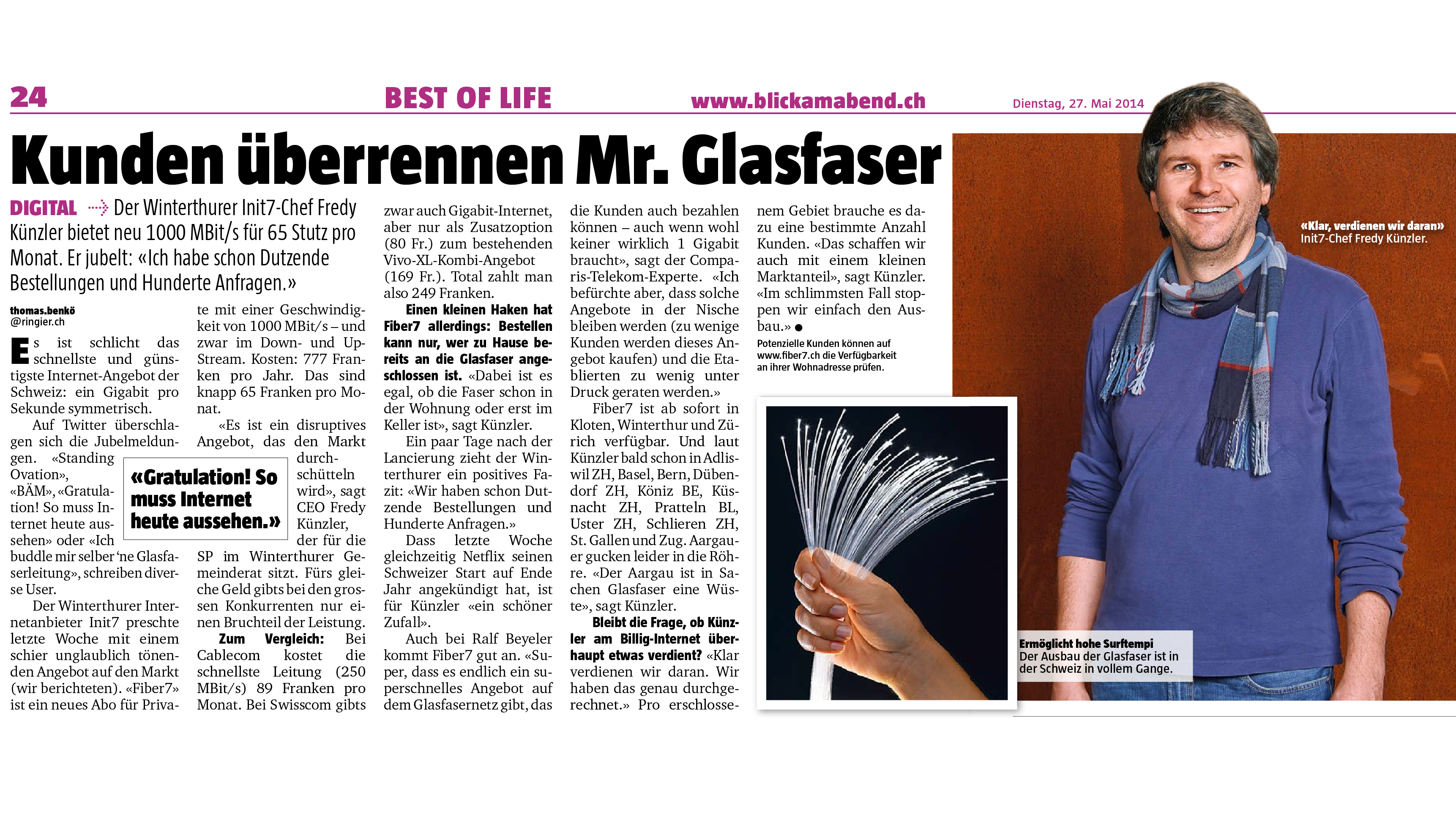by Fredy Künzler
Reading time: 5 minutes
Ten years of Fiber7
The 22nd of May 2014 marks an important date in Init7’s company history. It was the birth of Fiber7. In retrospect, there is actually a “before” and an “after”. Until 2013, Init7 was primarily active in the business customer and wholesale business. We generated only 12% of our 2013 revenue with private customers, mainly with DSL connections based on the ex-monopolist’s BBCS (Broadband Connectivity Service) platform. The main business was our international internet backbone, which made it possible to produce high-quality bandwidth for other internet providers and web hosting companies. BGP4 (Border Gateway Protocol version 4) was (and is) our expertise.
However, around 2012, it became apparent that margins in the IP wholesale business were becoming increasingly tight. International providers with better cost structures were pushing prices down. Swiss salaries for good network engineers were no longer competitive with the salaries paid to equally well-qualified Romanians or Spaniards. International competitors were operating their NOCs (Network Operation Centres) at cheaper locations. So something new had to be found to make Init7 economically viable in the long term, because relocating our qualified jobs to low-wage countries was out of the question.
The fiber optic expansion begins
Towards the end of the 2000s, the fiber optic expansion began, initially rather hesitantly and only in the cities. At that time, DSL from the incumbent and its several dozen resellers, which was in competition with internet on the television cable network, was of course predominant. Cablecom (from 2011 UPC Cablecom) had the largest coverage area at the time. However, the poor reputation of Cablecom’s customer service was just as bad, which leveled out the technical superiority of TV cable in favour of DSL. In addition, various municipal utilities successively established a wholesale platform on the newly created fiber optic network – partly legitimized by municipal referendums – which was based on the well-known BBCS platform in terms of its function. The best known was certainly the “Zürinet” of the energy supplier of the city of Zurich.
Barely there, already broken: fiber optics à la Zürinet
Init7 too decided to offer services on these new fiber optic infrastructures in 2009 and was able to acquire several hundred private customers in St. Gallen, Winterthur and Zurich over time. But we were never really happy with Zürinet & Co.: technical restrictions, a lack of IPv6 compatibility and energy-consuming Optical Network Terminators (ONT) with no benefit and – worst of all – incompetent product managers, put an end to the potential innovation. Asymmetric bandwidths, i.e. more downstream than upstream speed, are a technical requirement for DSL and cable, but are not justified for fiber optics. Unless the product manager wants to achieve a specific goal.
The available Zürinet bandwidths were therefore essentially a copy-paste of the DSL wholesale offer on the copper network, as were the wholesale prices. However, the question of why fiber optics were built if they were artificially limited to DSL speed was never answered by those responsible. Symmetrical bandwidth was only available for very expensive business customer connections. In short, the Zürinet product managers had ruined the fiber optic wholesale product right from the start and there was nothing we could do about it.
It only changed when the incumbent – under pressure from an antitrust investigation by the Competition Commission into possible territorial and price agreements between various municipal utilities and the former monopolist – slowly but steadily made the ALO (Access Line Optical) wholesale offer available to other service providers from 2011. ALO is the unbundled optical fiber to the subscriber line; the copper counterpart, the local loop, was booming at the time, as the then Sunrise (still without UPC) was unbundling hundreds of thousands of lines. In contrast to the local loop, however, ALO was not regulated in terms of price.
Driven by economic pressure, frustration with the inadequate pre-service products of the local public service providers and the new option of being able to obtain dark fiber with ALO, we started looking closely in 2013 at how an affordable Internet offering could be realized “without being broken”. As a newcomer to the private customer market, it was of course only possible to make a disruptive entry, as no one would change a functioning connection for 5% cheaper or 5% better. So a product had to be created that outshone everything that had existed before.
Gigabit by the competitors: expensive and asymmetrical
For once, the incumbent took on the role of pioneer and was the first provider to launch a gigabit Internet offer (asymmetric with 100 Mpbs upload speed) a few months before us, albeit only in combination with digital television and landline telephony for a whopping CHF 249 per month. A subscription that exceeded the willingness to pay of most households.
This meant that all the ingredients for the “fastest Internet without being broken” menu were actually in place: symmetrical Gigabit Ethernet on fiber optics (it’s not rocket science), Cisco switch from the grey market (we didn’t have much investment capital), IPv4 and IPv6 with a decent backbone and lots of peering (we already had), rack space in the telephone exchanges (called collocation & building infrastructure and a prerequisite for a regulated telecom landscape), backhaul fiber optics with 10Gbps capacity (we were able to negotiate) and competitors’ products that were either a multiple times more expensive or worse.
We didn’t have an annoying product manager with his “what if” Excel sheets to optimize the ARPU (average revenue per user – “the” key figure of the telecom industry), so network engineers did the product design and “forgot” to configure the rate limiter to 20/4 Mbps. We also ignored the marketing rule that you should always offer three products (Basic, Medium, Premium) and that the majority of customers would then opt for the middle one, with the slogan “Fiber7. No Limits.”. Of course, a rudimentary website with an order form and a logo had to be created.
In fact, Fiber7 was cobbled together by a few nerds. The ordering process, automatic billing, marketing – everything that is actually needed for a successful telecom product launch was not in place. But the launch date was fixed: 22nd May 2014. We knew how social media worked and what needed to be done to use the multiplier of traditional media.
t – 24h.
— Init7 – Fiber7™ (@fiber7_ch) May 21, 2014
The birth of the Gigabit Society
And that is why Fiber7 is celebrating its tenth anniversary today.
Fiber7 was the first symmetrical gigabit offering in Switzerland at an affordable price. We can therefore claim to have been in pole position at the birth of the Swiss Gigabit Society. We are a little proud of this.

PS. Actually, I was a bit nervous: we had to rent backhaul fiber from the incumbent for the PoPs in the telephone exchanges. They in fact only wanted to sell us managed bandwidth. However, a 10 Gbps offer was not yet available at the time and so we negotiated a price list to obtain the “Fiberline” (dark fiber) product to connect our PoPs. I neglected to mention what we actually wanted to do – namely shake up the fiber optic market for private customers with a disruptive product – and didn’t specifically mention it when I was asked questions in this regard. So I let my negotiating partners believe that we were offering something new for business customers, because I was terrified that the ex-monopolist might sneak in at the last minute and refuse to supply us with Fiberline if they found out that their own gigabit product at CHF 249 per month was no longer as sexy as our Fiber7 at CHF 64.75.
